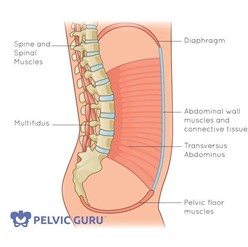12/02/2022
Want to improve your sport performance? Train your pelvic floor!
 By Jennifer Hopp, MD, Program Director for the Women’s Sports Medicine Program
By Jennifer Hopp, MD, Program Director for the Women’s Sports Medicine Program
The demands of every sport are different but the one thing that is integral to athletic performance is your core and pelvic floor strength. Your pelvic floor muscles are part of your core and contribute to your overall core strength and stability. The core can be thought of as an anatomical box composed of numerous muscle groups, including the abdominals in the front, the paraspinal and gluteal muscles in back, the diaphragm at the top, and the hip girdle and pelvic floor muscles at the bottom. Your pelvic floor is located at the base of your pelvis and creates a hammock to support your abdominal cavity by connecting from your pubic bone to your tailbone, and to your sit bones.
Why is this important for athletic performance and sports?
How the pelvic floor muscles help with athletic performance:
|
Improves strength and lumbopelvic stability which allows for improved coordination and power through your upper and lower extremities |
Higher core and spinal stability provides a more stable base, which allows the force generated by the upper or lower extremity muscles to be more efficiently transformed into work. When the core is unstable, it will absorb the force generated; thus, less force will be transformed into work. Research has shown that baseball pitchers with better lumbopelvic control demonstrated better accuracy (walks + hits/inning) and endurance (innings pitch). Other research has proven that improved core strength can improve swing stability and velocity of golf club, racket, or bat movement. |
|
Improves response time and ability to change direction |
Increased core stability leads to improved postural control which decreases the time it takes to change positions, change directions, and respond to opponent’s actions. |
|
Helps manage intra-abdominal pressure changes |
During impact activities the pelvic floor muscles and abdominal muscles contract to stabilize the torso during movements such as jumping. The pelvic floor helps manage the impact and pressure changes for improved power with jumping and more stability with landing. |
|
Improves breathing mechanics |
The pelvic floor muscles also work in tandem with the diaphragm and can aid in endurance and recovery by improving breathing mechanics. |
|
Decreases the risk of injuries |
Research has shown that increased core strength and pelvic floor strength can decrease the risk of injury in athletes. One study showed that in baseball players, they found that pitchers with less core control and increased pelvic mobility were 3 times more likely to miss at least 30 days than those pitchers demonstrating lower amounts of lumbopelvic motion. Research has also found an association between core weakness and hip muscle strength imbalance with lower back injuries, and knee injuries in female athletes. |
If you are having difficulty with activating or using these muscles you can see a pelvic floor physical therapist who can create a program specifically for your needs!
Citations:
Tim S, Mazur-Bialy AI. The Most Common Functional Disorders and Factors Affecting Female Pelvic Floor. Life (Basel). 2021 Dec 14;11(12):1397. doi: 10.3390/life11121397. PMID: 34947928; PMCID: PMC8704638.
Shaw JM, Nygaard IE. Role of chronic exercise on pelvic floor support and function. Curr Opin Urol. 2017 May;27(3):257-261. doi: 10.1097/MOU.0000000000000390. PMID: 28212118; PMCID: PMC5433620.
Lee K. Activation of Pelvic Floor Muscle During Ankle Posture Change on the Basis of a Three-Dimensional Motion Analysis System. Med Sci Monit. 2018 Oct 10;24:7223-7230. doi: 10.12659/MSM.912689. PMID: 30301876; PMCID: PMC6192454.
Nipa SI, Sriboonreung T, Paungmali A, Phongnarisorn C. The Effects of Pelvic Floor Muscle Exercise Combined with Core Stability Exercise on Women with Stress Urinary Incontinence following the Treatment of Nonspecific Chronic Low Back Pain. Adv Urol. 2022 Sep 5;2022:2051374. doi: 10.1155/2022/2051374. PMID: 36105867; PMCID: PMC9467742.
Nuhmani S. Correlation between Core Stability and Upper-Extremity Performance in Male Collegiate Athletes. Medicina (Kaunas). 2022 Jul 23;58(8):982. doi: 10.3390/medicina58080982. PMID: 35893097; PMCID: PMC9332685.
Silfies SP, Ebaugh D, Pontillo M, Butowicz CM. Critical review of the impact of core stability on upper extremity athletic injury and performance. Braz J Phys Ther. 2015 Sep-Oct;19(5):360-8. doi: 10.1590/bjpt-rbf.2014.0108. Epub 2015 Sep 1. PMID: 26537806; PMCID: PMC4647147.
Luo S, Soh KG, Soh KL, Sun H, Nasiruddin NJM, Du C, Zhai X. Effect of Core Training on Skill Performance Among Athletes: A Systematic Review. Front Physiol. 2022 Jun 6;13:915259. doi: 10.3389/fphys.2022.915259. PMID: 35755428; PMCID: PMC9227831.
Pictures:
https://raisingchildren.net.au/pregnancy/health-wellbeing/healthy-lifestyle/pelvic-floor-care
About the authors
 Jennifer Hopp, MD, is a board certified Primary Care Sports Medicine Physician. She is the Program Director for the Women’s Sports Medicine Program, specializing in multi-disciplinary care for active and athletic female patients. She cares for athletes of all ages and abilities, from the weekend warrior to the professional athlete. Prior to moving to New Hampshire in 2020, she was the team physician at several high schools and the University of Richmond. She is a team physician at the University of New Hampshire and enjoys providing medical coverage for games and races. An avid runner and cyclist herself, she has experienced many injuries first-hand and understands that recovering from an injury is just as important as being an athlete.
Jennifer Hopp, MD, is a board certified Primary Care Sports Medicine Physician. She is the Program Director for the Women’s Sports Medicine Program, specializing in multi-disciplinary care for active and athletic female patients. She cares for athletes of all ages and abilities, from the weekend warrior to the professional athlete. Prior to moving to New Hampshire in 2020, she was the team physician at several high schools and the University of Richmond. She is a team physician at the University of New Hampshire and enjoys providing medical coverage for games and races. An avid runner and cyclist herself, she has experienced many injuries first-hand and understands that recovering from an injury is just as important as being an athlete.
 Kristina is a physical therapist at WDH with a focus on pelvic floor disorders in men and women. Kristina attended Elon University where she earned her BS in Exercise Science and then went on to earn her Doctorate degree in Physical Therapy from Franklin Pierce University. She continued her education into pelvic health by taking numerous courses through Herman & Wallace. In her spare time, she enjoys strength training and participating in outdoor activities/ co-ed sport leagues.
Kristina is a physical therapist at WDH with a focus on pelvic floor disorders in men and women. Kristina attended Elon University where she earned her BS in Exercise Science and then went on to earn her Doctorate degree in Physical Therapy from Franklin Pierce University. She continued her education into pelvic health by taking numerous courses through Herman & Wallace. In her spare time, she enjoys strength training and participating in outdoor activities/ co-ed sport leagues.